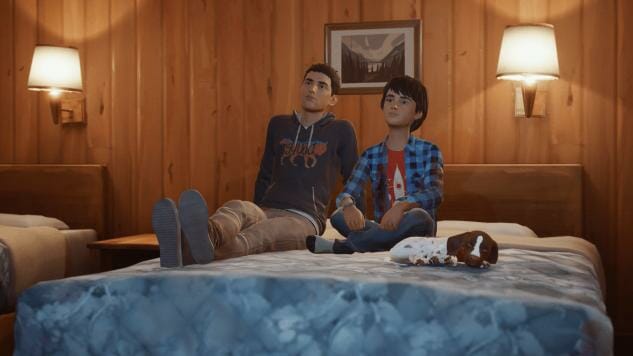“I’m invisible,” Daniel Diaz tells his big brother Sean late into the first episode of Life is Strange 2, whispering it with pure joy as if invisibility is a superpower. It makes me think of how, as I’ve grown up, I’ve often felt invisible—and how it’s never felt anything like a supernatural gift.
Life is Strange is a series that stars invisible people: Max Caulfield, who felt invisible because she thought she was shy and boring; Chloe Price, who acted out to make her pain over her father’s death hypervisible to a society that didn’t care about her; and Sean and Daniel Diaz, Latin-American children of immigrants who are simultaneously invisible and hypervisible in Trump’s America. As a result, it has deeply affected someone like me, a bisexual Latin-American who is the daughter of an immigrant and is thus constantly prone to invisibility and erasure. Life is Strange 2 captures that specific feeling of invisibility and hypervisibility as a Latinx person perfectly, and in the process has given me the most validating experience I’ve had in videogames.
I’m used to getting crumbs in the gaming industry. The most representation I’ve ever had is Sombra in Overwatch—who, due to the nature of her game, will never achieve the depth of a fully realized character. Representation has often come in sad and stereotypical forms like Jackie from Cyberpunk 2077, which I wrote about after seeing the game’s E3 demo. I’m also used to downright erasure, like how the industry’s beloved Lara Croft was originally a Latina named Laura Cruz before she was anglicized. So, when Life is Strange 2 was announced, I thought of all this and how overwhelmingly white the first season was, and I was cautious, to say the least.
But it’s almost immediately clear that the developers did their proper homework for Life is Strange 2, doing justice by the minorities it chooses to focus its story on. I can’t quite capture into words the feeling of finally being seen as a person; of being seen and feeling “good enough” to be the main hero; of not having stereotypical and othering accents imposed upon people who look like me; of hearing Spanish words used correctly and in ways that real bilingual Latinx people use them, and by real Latinx voice actors.
It also captures the real pain that Latinx people like me experience as we simply try to exist. It conveys the anxiety people of color feel when they walk into a room or area and see that they’re one of the few non-white people—if not the only. It shows the dread that my friends and I shared during the 2016 presidential election in ways exactly like Sean and his best friend Lyla do in their text messages. Like them, we refused to reference Trump by name and tried to convince ourselves there would be no way he would get elected—even though we knew how much a significant portion of white America hates people like us. It shows our pain of seeing brown and black men wrongfully lose their lives at the hands of white policemen across the country at staggering rates. Life is Strange 2 explores these aspects of our lives with a degree of authenticity that is rare in videogames, capturing a vital fragment of our experiences and helping others understand what they’re like.
The first season of Life is Strange changed my life because it helped me come to terms with my sexuality after years of denial; it’s the reason why I came out to my mother. And while only one episode is out, this season of Life is Strange is already shaping up to be an equally emotionally resonant experience. During the last moments of the episode, I couldn’t help but cry because my chest was overwhelmed with a mixture of emotions: sadness for Sean and Daniel and all they go through, amazement at how incredible of a first episode it was, and more than anything, overwhelming gratitude over feeling seen.
Life is Strange continues to set examples by shining the spotlight on people whom society tends to ignore, conveying that a story about two Latinx boys in a white supremacist world is every bit as important as a story about two queer white women—and, considering our current political climate, one could argue even more. In a time in which the humanity of Latinx people is constantly attacked, Life is Strange 2 sees us, our joys, our pains and our nuances, and it makes the explicit choice to validate us. When he’s older, Daniel may realize that being invisible isn’t as great as it seems; it’s being visible, being seen and heard, that lets us live fuller lives.
Natalie Flores is a Paste
intern who specializes in videogames. She’s on Twitter @heartimecia.